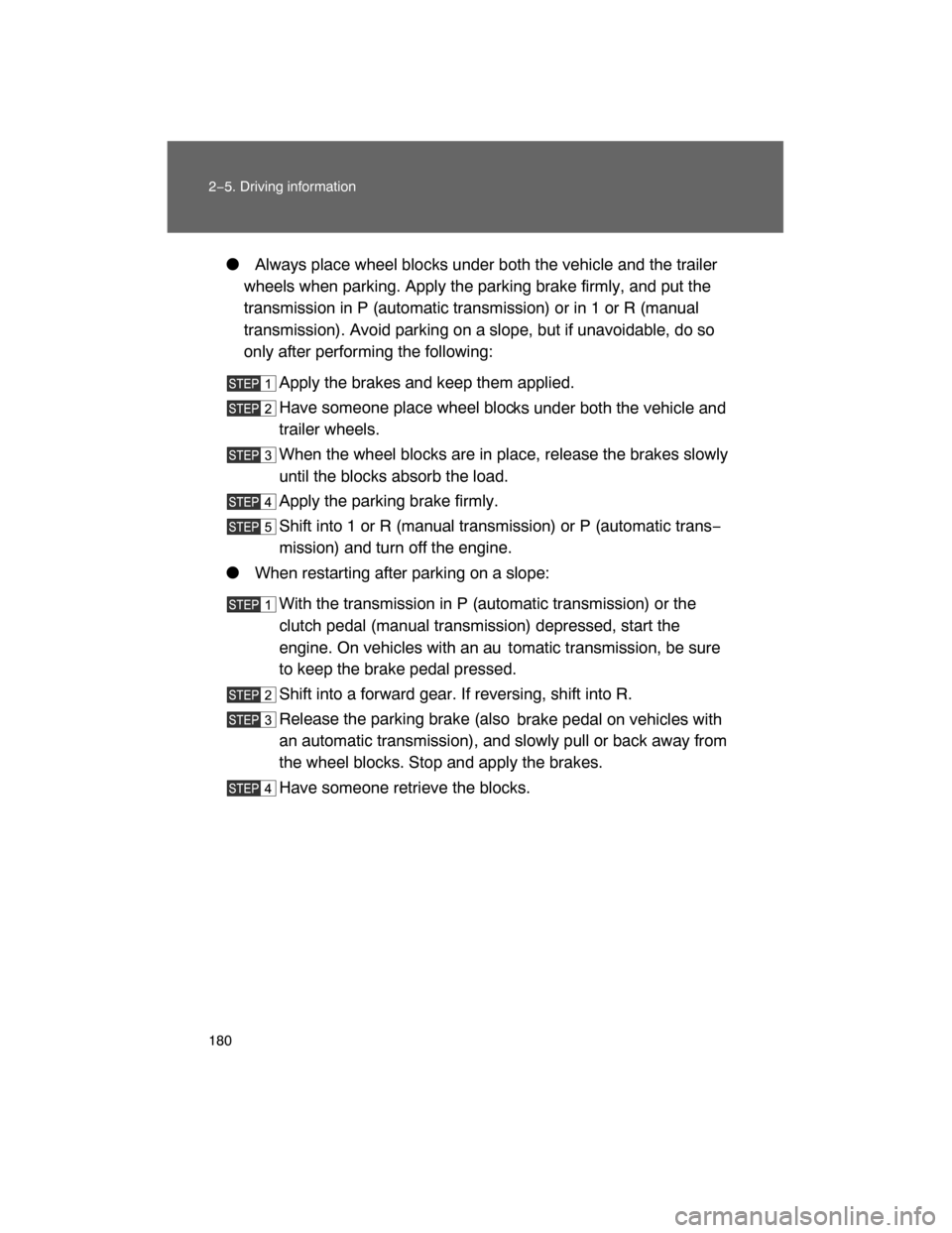Page 154 of 400

156
2−4. Using other driving systems
Driving assist systems
When VSC/TRAC are operating
If the vehicle is in danger of slip−
ping, or if the rear wheels (2WD
models) or all wheels (4WD
models) spin, the indicator light
flashes to indicate that VSC/
TRAC have been engaged.
A buzzer (intermittent) sounds to
indicate that VSC is operating. To help enhance driving safety a nd performance, the following sys�
tems operate automatically in res
ponse to various driving situations.
Be aware, however, that these systems are supplementary and
should not be relied upon too h
eavily when operating the vehicle.
� ABS (Anti�lock Brake System)
Restrains the vehicle from slipping when driving on slick road surfaces
or in the event of sudden braking.
� Brake Assist
Generates an increased level of braking force after the brake pedal is
depressed, when the system detects a panic stop situation.
� VSC (Vehicle Stability Control)
Helps the driver to control skidding when swerving suddenly or turning
on slippery road surfaces.
� TRAC (Traction Control)
Maintains drive power and prevents the rear wheels (2WD models) or
all wheels (4WD models) from spinning when starting the vehicle or
accelerating on slippery roads.
Page 156 of 400
158 2−4. Using other driving systems
� Sounds and vibrations caused by
the ABS, TRAC, VSC and brake
assist system
�A sound may be heard from the engine compartment when the engine is
started or just after the vehicle begins to move. This sound does not indi−
cate that a malfunction has occurred in any of these systems.
� Any of the following conditions may occur when the above systems are
operating. None of these indicates that a malfunction has occurred.
�Vibrations may be felt through the vehicle body and steering.
�A motor sound may be heard after the vehicle comes to a stop.
�The brake pedal may pulsate slightly after the ABS is activated.
�The brake pedal may move down slightly after the ABS is activated.
� If the brake system overheats
TRAC will cease operation and a buzzer will sound to alert the driver. Stop
the vehicle in a safe place. (There is
no problem with continuing normal driv−
ing.)
Page 176 of 400

178 2−5. Driving information
Trailer towing tips
Your vehicle will handle differently when towing a trailer. The three
main causes of vehicle−trailer ac cidents are driver error, excessive
speed and improper trailer loading. Keep these in mind when towing.
�
Before starting out, check the trailer ’s light and the vehicle−trailer
connections. Recheck after driving a short distance.
� Practice turning, stopping and reve rsing with the trailer attached in
an area away from traffic until you become accustomed to the feel
of the vehicle.
� Reversing with a trailer attached is
difficult and requires practice.
Grip the bottom of the steering wheel and move your hand to the
left to move the trailer to the left. Move your hand to the right to
move the trailer to the right. (This generally opposite to reversing
without a trailer attached.) Avoid sharp or prolonged turning. Have
someone guide you when reversing to reduce the risk of an acci−
dent.
� As stopping distance is increased when towing a trailer, vehicle−to−
vehicle distance should be increased. For each 10 mph (16 km/h)
of speed, allow at least o
ne vehicle and trailer length.
� Avoid sudden braking as you may skid, resulting in jackknifing and
loss of control. This is especially true on wet or slippery surfaces.
�
Avoid jerky starts or sudden acceleration. Vehicles with a manual
transmission, prevent excessive cl
utch slippage by keeping engine
rpm low and not racing the engine. Always start out in first gear.
�Avoid jerky steering and sharp turns, and slow down before mak−
ing a turn.
Page 178 of 400

180 2−5. Driving information
� Always place wheel blocks under both the vehicle and the trailer
wheels when parking. Apply the parking brake firmly, and put the
transmission in P (automatic transmission) or in 1 or R (manual
transmission). Avoid parking on a slope, but if unavoidable, do so
only after performing the following:
Apply the brakes and keep them applied.
Have someone place wheel bloc
ks under both the vehicle and
trailer wheels.
When the wheel blocks are in place, release the brakes slowly
until the blocks absorb the load.
Apply the parking brake firmly.
Shift into 1 or R (manual transmission) or P (automatic trans−
mission) and turn off the engine.
� When restarting after parking on a slope:
With the transmission in P (automatic transmission) or the
clutch pedal (manual transmission) depressed, start the
engine. On vehicles with an au tomatic transmission, be sure
to keep the brake pedal pressed.
Shift into a forward gear. If reversing, shift into R.
Release the parking brake (also
brake pedal on vehicles with
an automatic transmission), and slowly pull or back away from
the wheel blocks. Stop and apply the brakes.
Have someone retrieve the blocks.
Page 251 of 400
254 3−5. Other interior features
After calibration, leave the syst em for 6 seconds or press the
SET button for about 2 seconds.
If the display returns to the outside temperature display, the calibra−
tion is complete.
� Circling calibration
Stop the vehicle where it is safe to drive in a circle.
Press the SET button
until the zone number
appears on the outside
temperature display.
Push the SET button.
“– –” will start moving.
Drive the vehicle in a cir−
cle at 5 mph (8 km/h).
If there is not enough space
to drive in a circle, drive
around the block until the
direction is displayed.
When the compass display
returns to the outside tem−
perature display, calibration
is complete.
When circling calibration fails, Er is displayed for 2 seconds and then COM−
PASS flashes. It also flashes when circling calibration is not completed.
If you want to cancel the calibration before it is complete, press the SET but−
ton for about 2 seconds.
Page 306 of 400
310 4−3. Do−it−yourself maintenance
*1: Vehicles with daytime running light
*2: Vehicles without daytime running light31 AM2 30 AIGN and GAUGE, multiport fuel
injection system/sequential multi−
port fuel injection system, starting
system
32 ABS SOL 30 AAnti−lock brake system, vehicle sta−
bility control system, traction con−
trol system, active traction control
system, AUTO LSD system
33 ALT 120 AAM1, AC 115V, DEFOG, DEFOG
NO.2, STOP, OBD, J/B, TOWING
TAIL, AUX LP and OFFROAD LP
34 HEATER 60 A Air conditioning system
35 AC 115V 80 A Power outlet
FuseAmpereCircuit
Page 323 of 400
328
5−1. Essential information
Fuel pump shut off system
Follow the procedure below to restart the engine after the system is
activated.
Turn the engine switch to the ACC or LOCK position.
Restart the engine.
NOTICE
� Before starting the engine
Inspect the ground under the vehicle.
If you find that fuel has leaked onto the ground, the fuel system has been
damaged and is in need of repair. Do not restart the engine.
To minimize the risk of fuel leakage when the engine stalls or an air�
bag inflates upon collision, the fuel
pump shut off system stops sup�
plying fuel to the engine.
Page 333 of 400

338 5−2. Steps to take in an emergency
CAUTION
�Maintenance of the tire
Each tire, including the spare (if provided), should be checked monthly
when cold and inflated to the inflation pressure recommended by the
vehicle manufacturer on the vehicle
placard or tire inflation pressure
label (tire and load information label). (If your vehicle has tires of a differ−
ent size than the size indicated on the vehicle placard or tire inflation
pressure label [tire and load information label], you should determine the
proper tire inflation pr
essure for those tires.)
As an added safety feature, your
vehicle has been equipped with a tire
pressure monitoring system (TPMS−ti re pressure warning system) that
illuminates a low tire pressure telltal e (tire pressure warning light) when
one or more of your tires is significantly under−inflated. Accordingly,
when the low tire pressu
re telltale (tire pressure warning light) illumi−
nates, you should stop and check your tires as soon as possible, and
inflate them to the proper pressure. Driving on a significantly under−
inflated tire causes the tire to overheat and can lead to tire failure.
Under−inflation also reduces fuel effi
ciency and tire tread life, and may
affect the vehicle’s handling and stopping ability.
Please note that the TPMS (tire pressure warning system) is not a sub−
stitute for proper tire main tenance, and it is the driver ’s responsibility to
maintain correct tire pressure, even if under−inflation has not reached the
level to trigger illu
mination of the TPMS low ti re pressure telltale (tire
pressure warning light).
Your vehicle has also been equipped with a TPMS (tire pressure warning
system) malfunction indicator to indi cate when the system is not operat−
ing properly. The TPMS (tire pressure warning system) malfunction indi−
cator is combined with the low tire pressure telltale (tire pressure
warning light). When the system det
ects a malfunction, the telltale will
flash for approximately one minute an d then remain continuously illumi−
nated. This sequence will
continue upon subsequent vehicle start−ups as
long as the malfunction exists. When the malfunction indi cator is illumi−
nated, the system may not be able to detect or signal low tire pressure
as intended.